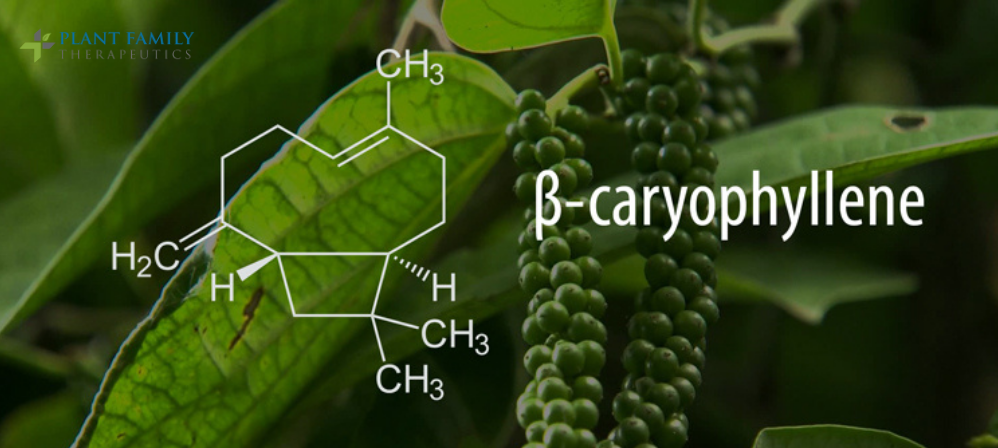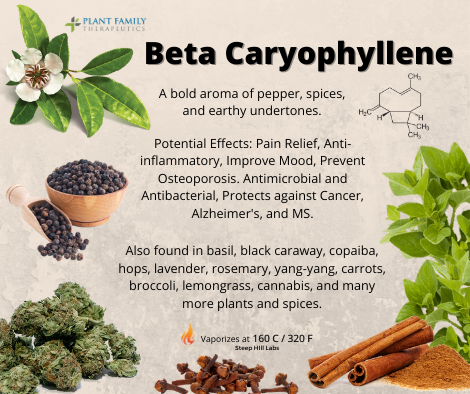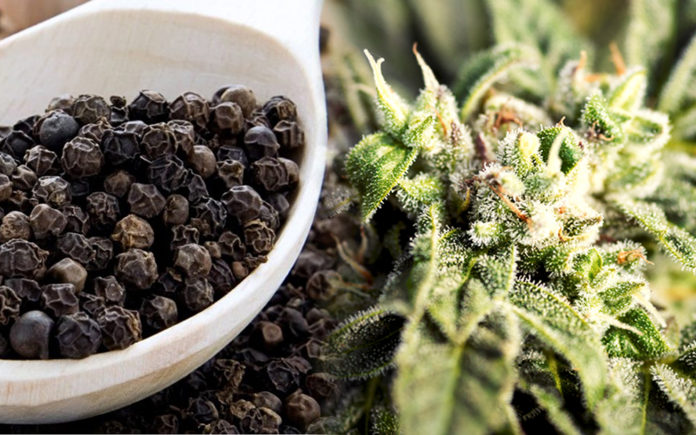This website requires you to be 21 years or older to enter. Please confirm your age below to continue.

April 26, 2021 – by Sandy Yanez
Despite vast advancements in scientists’ understanding of the endocannabinoid system, the past 30 years of research has generally created more questions than answers. While THC’s action within the body is well characterized and CBD’s complex mechanisms are becoming more evident, there are a multitude of other components of cannabis demonstrating enormous healing potential that we are just scratching the surface on.
To better understand the action of cannabis in the body, one must look beyond the cannabinoids and consider the terpene profile, which is the second-most abundant chemical group in the plant.
In this article I will be discussing Beta-Caryophyllene (pronounced: carry-awful-leen), a cannabinoid and terpene with tremendous potential.
What Is Beta-Caryophyllene?
Beta-caryophyllene (β-caryophyllene or BCP) is one of the most abundant terpenes found in cannabis. Often referred to as BCP, this naturally occurring terpene is not just present in cannabis — it is quite common among plants, including many fruits, vegetables, herbs, and spices. In cannabis, BCP most likely contributes to a euphoric relaxation and creates the cozy, relaxed, happy mood often associated with some cannabis varieties.
When you think of the smell of BCP, think fresh cracked black pepper in abundance with an earthy, spicey, or woody smell, distinct enough that drug-sniffing dogs are trained to detect a version of it when looking for cannabis.
BCP’s most distinguishing characteristic is that it can be categorized as both a cannabinoid and a terpene. This special component of the cannabis plant was first discovered in 1964 by pioneering Israeli academic researcher Raphael Mechoulam, who identified it as a terpene. It wasn’t until 2008 that a study by a group of German scientists observed the rare behavior and characteristics that indicated that BCP can also be labeled a cannabinoid.
Similar to other terpenes, BCP contributes to the overall effects of cannabis by way of the entourage effect— interacting with and changing how other molecules in the plant affect the body. However, unlike most other terpenes, BCP directly activates one of the two major receptors in the endocannabinoid system and has even been described as a dietary cannabinoid.
BCP is approved by the United States Food and Drug Administration (FDA) and the European Food and Safety Authority (EFSA) as a food additive, taste enhancer, and flavoring agent as it is generally recognized as safe (GRAS).
BCP’s Many Benefits The unique molecular structure of BCP allows it to easily bind to a specialized receptor in the body called the cannabinoid receptor type 2, or simply CB2. These CB2 receptors, which do not produce any psychoactive effects when activated, are largely present in the gastrointestinal system, the peripheral nervous system (the part of the nervous system outside of the brain and spinal cord), and the immune system.

Due to its unique ability to bind with CB2 receptors, BCP has potent anti-inflammatory, antimicrobial, antibacterial, and antioxidant properties. It is known to help relieve anxiety and pain, reduce cholesterol, prevent Osteoporosis, and treat seizures. Also, research has shown BCP’s ability to fight systemic inflammation, may help against certain neurodegenerative diseases and cancers and aid in the recovery of substance addiction.
Anti-Inflammatory Properties – reduces inflammation in the brain and chemicals that cause oxidative stress associated with inflammation. These properties can aid the brain from swelling during a stroke and improve its outcomes. And, it has been shown to reduce gut inflammation.
Pain – it reduces pain related to the nervous system and it can release the same endorphins as morphine without being addictive. Past research has demonstrated BCP’s value as a local anesthetic. More recent research shows that BCP is highly effective in the treatment of long lasting, debilitating pain states, and recommends that it be used as a substitute for the highly addictive pharmaceuticals used to treat chronic pain.
Antibacterial & Antimicrobial Properties – studies suggest that BCP helps fight bacterial dental plaque build-up and makes it a potential alternative to prescribed medications like chlorhexidine. Also, it reduces microorganisms like Streptococcus pneumonia, Haemophilus influenza, and E. coli.
Improves Your Mood – not only can this terpene help heal and protect the body, but it also positively influences the mind. A study published by the journal Physiology and Behavior, discusses the role of CB2 receptors in anxiety and depression disorders, highlighting the potential of BCP as a treatment for anxiety and depression. The study demonstrates that BCP is effective in producing anti-anxiety and anti-depressant effects and has beneficial pharmacological effects over existing benzodiazepines and SSRI’s.
Osteoporosis – studies suggest BCP may work as a therapeutic agent for the prevention and treatment of osteoporosis. The theory is that it is accomplished by increasing the building (mineralization) of stronger bones while decreasing their breakdown (adipogenesis and osteoclastogenesis). These results indicate that BCP may be a useful tool in the treatment of osteoporosis.
Cancer – in cancer studies, BCP demonstrated synergy with the chemotherapy drug Paclitaxel on human tumor cell lines, and alone it stimulates apoptosis(cell death) and suppresses tumor growth. Fidyt states, “In a medical practice, the application of BCP and BCPO (B-Caryophyllene Oxide) in combination with the classical anticancer drugs could bring many benefits, thus could potentiate the efficacy of used chemotherapeutics, elicit the supplementary antineoplastic effect, as well as reduce the refractory cancer pain at the same time.” And “BCP and BCPO induce apoptosis and suppress proliferation of cancer cells as well as reduce levels of tumor angiogenesis and metastasis markers.”
Alzheimer’s Disease – given orally, BCP prevented cognitive impairment in APP/PS1 mice, and this positive cognitive effect was associated with reduced β-amyloid burden in both the hippocampus and the cerebral cortex suggesting BCP as an attractive molecule for the development of new drugs with therapeutic potential for the treatment of Alzheimer’s disease.
Multiple Sclerosis – BCP inhibited the initiation and progression of clinical and neurological symptoms of experimental autoimmune encephalomyelitis (EAE), which was linked to the inhibition of immune cell activation, neuroinflammation, and demyelinating processes in the CNS. Conclusions demonstrated that BCP is a promising therapeutic molecule for the treatment of MS and other autoimmune diseases.
Alcoholism – a study published in the journal Pharmacology, Biochemistry and Behavior revealed BCP may help treat alcoholism. Researchers discovered that its activation of CB2 receptors within the ECS resulted in decreased alcohol consumption and preference. BCP also demonstrated potential in treating or preventing hepatic injury associated with oxidative stress, inflammation and steatosis

Where to find BCP
As mentioned above, BCP is approved by the United States Food and Drug Administration (FDA) and the European Food and Safety Authority (EFSA) as a food additive, taste enhancer, and flavoring agent as it is generally recognized as safe (GRAS). Please keep in mind, while BCP may be labeled as safe to
ingest, not all terpenes are considered safe, nor are they all processed/produced the same. Shop for products that are verified through a lab certification of analysis (COA), ensuring the product is safe to use.
BCP is found in many common plants throughout nature but is highly concentrated in several plants known to have health and medicinal properties. This includes the cannabis plant, black pepper, copaiba, basil, cinnamon, cloves, hops, lavender, oregano, rosemary, ylang-ylang and many more.
Many dark green vegetables are high in BCP like broccoli which is also full of vitamin K and C, folic acid, potassium, and fiber. So, if you’re looking for a heavy dose of beta-caryophyllene consider creating a broccoli casserole or side dish seasoned with rosemary, oregano, and black pepper.
Cannabis cultivars high in BCP include – Chemdawg, GSC or Girl Scout Cookies, Sour Diesel, Original Glue or GG4, Blue Dream, Cookies and Cream, and Gelato. Cannabinoids results may vary depending on seeds purchase and grow conditions.
Conclusion
Overall, BCP is one of those powerful natural compounds found in cannabis that has tremendous potential. Due to its unique behavior and potential to deliver effects directly to the peripheral nervous system without the psychoactivity, it is attracting more research, particularly among oncologists. In the near future, those findings will hopefully be further supported by clinical trials and wider investigations into terpenes as a whole.
References:
Alberti, T. B., Barbosa, W. L., Vieira, J. L., Raposo, N. R., & Dutra, R. C. (2017). (-)-β-Caryophyllene, a CB2 receptor-selective phytocannabinoid, suppresses motor paralysis and neuroinflammation in a murine model of multiple sclerosis. International journal of molecular sciences, 18(4), 691. https://doi.org/10.3390/ijms18040691
Al Mansouri, S., Ojha, S., Al Maamari, E., Al Ameri, M., Nurulain, S. M., & Bahi, A. (2014). The cannabinoid receptor 2 agonist, β-caryophyllene, reduced voluntary alcohol intake and attenuated ethanol-induced place preference and sensitivity in mice. Pharmacology, biochemistry, and behavior, 124, 260–268. https://doi.org/10.1016/j.pbb.2014.06.025
Bahi, A., Al Mansouri, S., Al Memari, E., Al Ameri, M., Nurulain, S. M., & Ojha, S. (2014). β-Caryophyllene, a CB2 receptor agonist produces multiple behavioral changes relevant to anxiety and depression in mice. Physiology & behavior, 135, 119–124. https://doi.org/10.1016/j.physbeh.2014.06.003
Cheng, Y., Dong, Z., & Liu, S. (2014). β-Caryophyllene ameliorates the Alzheimer-like phenotype in APP/PS1 Mice through CB2 receptor activation and the PPARγ pathway. Pharmacology, 94(1-2), 1–12. https://doi.org/10.1159/000362689
Francomano, F., Caruso, A., Barbarossa, A., Fazio, A., La Torre, C., Ceramella, J., Mallamac, R., Saturnino, C., Lacopetta, D., & Sinicropi, MS. (2019). β-Caryophyllene: A Sesquiterpene with countless biological properties. Applied Sciences. 9(24):5420. https://doi.org/10.3390/app9245420
Ferber, S. G., Namdar, D., Hen-Shoval, D., Eger, G., Koltai, H., Shoval, G., Shbiro, L., & Weller, A. (2020). The “Entourage Effect”: Terpenes coupled with cannabinoids for the treatment of mood disorders and anxiety disorders. Current neuropharmacology, 18(2), 87–96. https://doi.org/10.2174/1570159X17666190903103923
Fidyt, K., Fiedorowicz, A., Strządała, L., & Szumny, A. (2016). β-caryophyllene and β-caryophyllene oxide-natural compounds of anticancer and analgesic properties. Cancer medicine, 5(10), 3007–3017. https://doi.org/10.1002/cam4.816
Gertsch, J., Leonti, M., Raduner, S., Racz, I., Chen, J. Z., Xie, X. Q., Altmann, K. H., Karsak, M., & Zimmer, A. (2008). Beta-caryophyllene is a dietary cannabinoid. Proceedings of the National Academy of Sciences of the United States of America, 105(26), 9099–9104. https://doi.org/10.1073/pnas.0803601105
Hwang, E., Kim, H., Lee, S., Kim, M., Kim, K., Han, G., Han, S., Lee, E., Yoon, J., Kim, D., Maeng, S., & Park, J. (2020). Antidepressant-like Effects of β-caryophyllene on restraint plus stress-induced depression. Behavioural Brain Research. 380. 112439. https://doi.org/10.1016/j.bbr.2019.112439
Irrera, N., D’Ascol,a A., Pallio, G., Bitto, A., Mannino, F., Arcoraci, V., Rottura, M., Ieni, A., Minutoli, L., Metro, D., Vaccaro, M., Altavilla, D., & Squadrito, F., (2020). β-Caryophyllene inhibits cell proliferation through a direct modulation of CB2 receptors in glioblastoma cells. Cancers. 12(4)1038. https://www.mdpi.com/2072-6694/12/4/1038/htm
Johnson, S., Rodriguez, D., Allred, K., (2020)”A Systematic review of essential oils and the endocannabinoid system: A connection worthy of further exploration”. Evidence-Based Complementary and Alternative Medicine. 2020(8035301)13. https://doi.org/10.1155/2020/8035301
Klauke, A. L., Racz, I., Pradier, B., Markert, A., Zimmer, A. M., Gertsch, J., & Zimmer, A. (2014). The cannabinoid CB₂ receptor-selective phytocannabinoid beta-caryophyllene exerts analgesic effects in mouse models of inflammatory and neuropathic pain. European neuropsychopharmacology : the journal of the European College of Neuropsychopharmacology, 24(4), 608–620. https://doi.org/10.1016/j.euroneuro.2013.10.008
Machado, K. da C., Paz, M. F. C. J., Oliveira Santos, J. V. de, da Silva, F. C. C., Tchekalarova, J. D., Salehi, B., Islam, M. T., Setzer, W. N., Sharifi-Rad, J., de Castro e Sousa, J. M., & Cavalcante, A. A. de C. M. (2020). Anxiety therapeutic interventions of β-Caryophyllene: A laboratory-based study. Natural Product Communications. https://doi.org/10.1177/1934578X20962229
Pieri, F. A., Souza, M. C., Vermelho, L. L., Vermelho, M. L., Perciano, P. G., Vargas, F. S., Borges, A. P., da Veiga-Junior, V. F., & Moreira, M. A. (2016). Use of β-caryophyllene to combat bacterial dental plaque formation in dogs. BMC veterinary research, 12(1), 216. https://doi.org/10.1186/s12917-016-0842-1
Segat, G. C., Manjavachi, M. N., Matias, D. O., Passos, G. F., Freitas, C. S., Costa, R., & Calixto, J. B. (2017). Antiallodynic effect of β-caryophyllene on paclitaxel-induced peripheral neuropathy in mice. Neuropharmacology, 125, 207–219. https://doi.org/10.1016/j.neuropharm.2017.07.015
Swamy, M. K., Akhtar, M. S., & Sinniah, U. R. (2016). Antimicrobial properties of plant essential oils against human pathogens and their mode of action: An Updated Review. Evidence-based complementary and alternative medicine : eCAM, 2016, 3012462. https://doi.org/10.1155/2016/3012462
Varga, Z. V., Matyas, C., Erdelyi, K., Cinar, R., Nieri, D., Chicca, A., Nemeth, B. T., Paloczi, J., Lajtos, T., Corey, L., Hasko, G., Gao, B., Kunos, G., Gertsch, J., and Pacher, P. (2018) β‐Caryophyllene protects against alcoholic steatohepatitis by attenuating inflammation and metabolic dysregulation in mice. British Journal of Pharmacology, 175: 320– 334. doi: 10.1111/bph.13722.
Yamaguchi, M., & Levy, R. M. (2016). β-Caryophyllene promotes osteoblastic mineralization, and suppresses osteoclastogenesis and adipogenesis in mouse bone marrow cultures in vitro. Experimental and therapeutic medicine, 12(6), 3602–3606. https://doi.org/10.3892/etm.2016.3818
Youssef, D.A., El-Fayoumi, H.M., & Mahmoud, M.F. (2019). Beta-caryophyllene protects against diet-induced dyslipidemia and vascular inflammation in rats: Involvement of CB2 and PPAR-γ receptors. Chem. Biol. Interact. 297, 16–24. https://doi.org/10.1016/j.cbi.2018.10.010